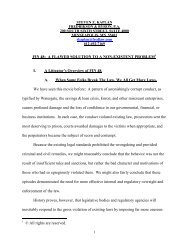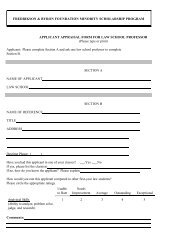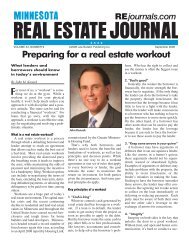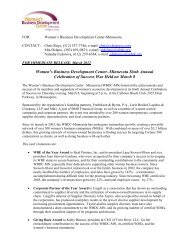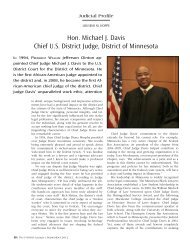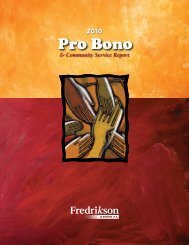Kivalina - Order Granting Motion to Dismiss for Lack of Jurisdiction
Kivalina - Order Granting Motion to Dismiss for Lack of Jurisdiction
Kivalina - Order Granting Motion to Dismiss for Lack of Jurisdiction
You also want an ePaper? Increase the reach of your titles
YUMPU automatically turns print PDFs into web optimized ePapers that Google loves.
1<br />
2<br />
3<br />
4<br />
5<br />
6<br />
7<br />
8<br />
9<br />
10<br />
11<br />
12<br />
13<br />
14<br />
15<br />
16<br />
17<br />
18<br />
19<br />
20<br />
21<br />
22<br />
23<br />
24<br />
25<br />
26<br />
27<br />
28<br />
Case4:08-cv-01138-SBA Document194 Filed09/30/09 Page10 <strong>of</strong> 24<br />
fac<strong>to</strong>rs is whether “resolution <strong>of</strong> the question demand[s] that a court move beyond areas <strong>of</strong><br />
judicial expertise[.]” Id. at 995.<br />
a) Judicially Discoverable and Manageable Standards<br />
In Alperin, the Ninth Circuit explained that focus <strong>of</strong> the second Baker fac<strong>to</strong>r is “not<br />
whether the case is unmanageable in the sense <strong>of</strong> being large, complicated, or otherwise<br />
difficult <strong>to</strong> tackle from a logistical standpoint. Rather, courts must ask whether they have the<br />
legal <strong>to</strong>ols <strong>to</strong> reach a ruling that is ‘principled, rational, and based upon reasoned distinctions.’”<br />
410 F.3d at 552. Thus, “[i]nstead <strong>of</strong> focusing on the logistical obstacles,” the relevant inquiry<br />
is whether the judiciary is granting relief in a reasoned fashion versus allowing the claims <strong>to</strong><br />
proceed such that they “merely provide ‘hope’ without a substantive legal basis <strong>for</strong> a ruling.”<br />
Id. (emphasis added).<br />
Plaintiffs contend that “[t]he judicially discoverable and manageable standards here are<br />
the same as they are in all nuisance cases.” Pls.’ Opp’n at 63. They assert that the salient<br />
inquiry underlying their federal nuisance claim is whether Defendants contributed <strong>to</strong> “an<br />
unreasonable interference with public rights[.]” Id. Resolution <strong>of</strong> what is “reasonable,”<br />
Plaintiffs assert, is <strong>to</strong> be determined by examining whether the conduct involves a “significant<br />
interference with the public health, the public safety, the public peace, the public com<strong>for</strong>t or the<br />
public convenience” and whether the conduct is “<strong>of</strong> a continuing nature” or has produced a<br />
“permanent or long lasting effect[.]” Id. However, the flaw in Plaintiffs’ argument is that it<br />
overlooks that the evaluation <strong>of</strong> a nuisance claim is not focused entirely on the<br />
unreasonableness <strong>of</strong> the harm. Rather, the factfinder must also balance the utility and benefit<br />
<strong>of</strong> the alleged nuisance against the harm caused.<br />
A public nuisance is defined as an “unreasonable interference with a right common <strong>to</strong><br />
the general public.” Restatement (Second) <strong>of</strong> Torts § 821(b)(1) (1979). Whether the<br />
interference is unreasonable turns on weighing “the gravity <strong>of</strong> the harm against the utility <strong>of</strong> the<br />
conduct.” Id. § 821 cmt. e. “The unreasonableness <strong>of</strong> a given interference represents a<br />
judgment reached by comparing the social utility <strong>of</strong> an activity against the gravity <strong>of</strong> the harm<br />
- 10 -




